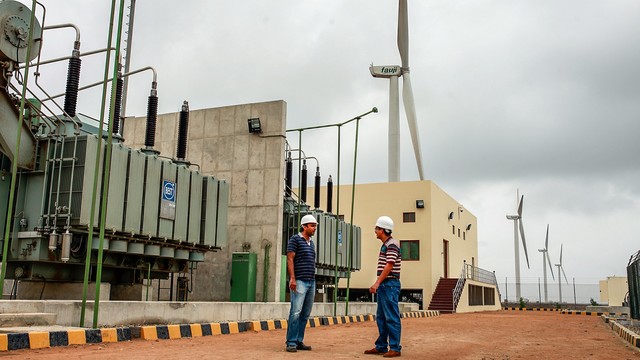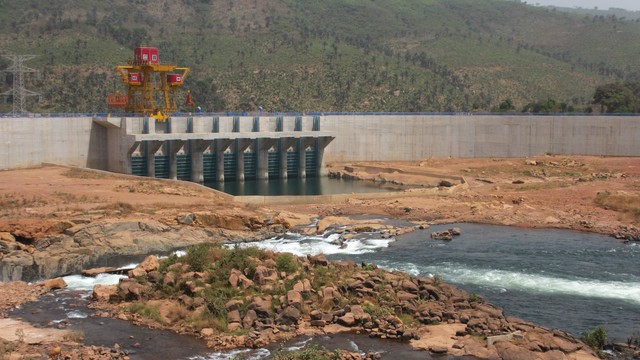Three big financial shifts put spotlight on social and environmental impacts of large dams — again
Three big shifts in flows of finance have rendered recent efforts to limit the environmental and social impacts of large dams marginal, say researchers, who urge the backers of new dams to adopt the Hydropower Sustainability Assessment Protocol to ensure safeguards are in place.

Women washing laundry at Sélingué dam, Mali, the second largest provider of energy for the country (Photo: Alioune Ba/Global Water Initiative)
The call comes at a key point in the story of large dams. In January the US Congress decided to prohibit US funding of them. Last month, researchers at the University of Oxford published a report [pdf] that said most large dams do more economic harm than good. Meanwhile disputes continue over large dams being built in Brazil, Ethiopia and the Democratic Republic of Congo, among others.
The real issue, says Jamie Skinner of the International Institute for Environment and Development (IIED), is whether it is possible to build dams to mitigate climate change AND deliver environmental and social outcomes.
"The answer is yes," says Skinner. "We have experience on how to do this, but there is often no specific obligation on developers to do so. They understandably want to reduce costs, so they focus on the easy bit, the concrete and the power lines, and usually only meet the minimum required for mitigation in national standards. The challenge is about where to aim in terms of delivering multiple benefits, such as local development, not just ‘clean’ energy and mitigation of climate change."
In a paper published today by IIED today, Skinner and Lawrence Haas show although changes in how dams are financed pose new risks, there are cost-effective approaches to mitigating them.
"The environmental and social impacts of large dams drew such attention in the 1990s that the dams' main backers – major bilateral and multilateral donors including the World Bank – first improved their investments in social and environmental protection and later withdrew support for dams," says Skinner, principal researcher at IIED.
"Today these players finance only 5-10 per cent of new dams, so although their standards have improved over the past ten years they do not have a major impact globally."
The paper identifies big shifts to the ways dams are financed that have weakened social and environmental safeguards.
- China has boosted dam construction at home and increased finance for dams in Africa, Asia and Latin America, but has not accepted the recommendations made by the World Commission on Dams in 2000 for mitigating social and environmental impacts
- International efforts to reduce greenhouse gas emissions have created new sources of finance through the global carbon market. The European Union's Emissions Trading Scheme is a major source of this funding but EU rules for screening new projects are weak and allow developers to self-assess potential impacts which are not then monitored
- Rising costs of oil and gas have made dams a more attractive investment opportunity for private banks, but few — especially in Asia where many dams are planned — have adopted the Equator Principles, for assessing and managing environmental and social risk in project finance transactions.
Skinner and Haas urge these sources of finance to use the Hydropower Sustainability Assessment Protocol to identify and limit the environmental and social impacts of dams.
"As it costs just US$60,000 to US$100,000 to perform, the Hydropower Sustainability Assessment Protocol is a very cost-effective approach in a sector whose project budgets can exceed US$1 billion," says Skinner.
The protocol was created in 2011 by a forum of experts and institutions representing industry, governments and NGOs. It uses 23 criteria in an independently certified assessment and monitoring tool that is currently the most effective way to assess an individual dams’ sustainability, according to the recommendations of the World Commission on Dams.
"The Hydropower Sustainability Assessment Protocol has many advantages," says Lawrence Haas, a former team leader in the World Commission on Dams secretariat. "It provides a numerical and visual output. It is done by an external certified assessor according to methods agreed by a multidisciplinary forum. And it can be reviewed and modified as new approaches arise, routinely informing decisions on whether to support dams, and how to manage of environmental and social impacts."
Download the report Watered Down? A review of social and environmental safeguards for large dam projects
Download the briefing paper, which summarises the findings
This material has been funded by UKAid from the UK Government, however the views expressed do not necessarily reflect the UK Government's official policies.



